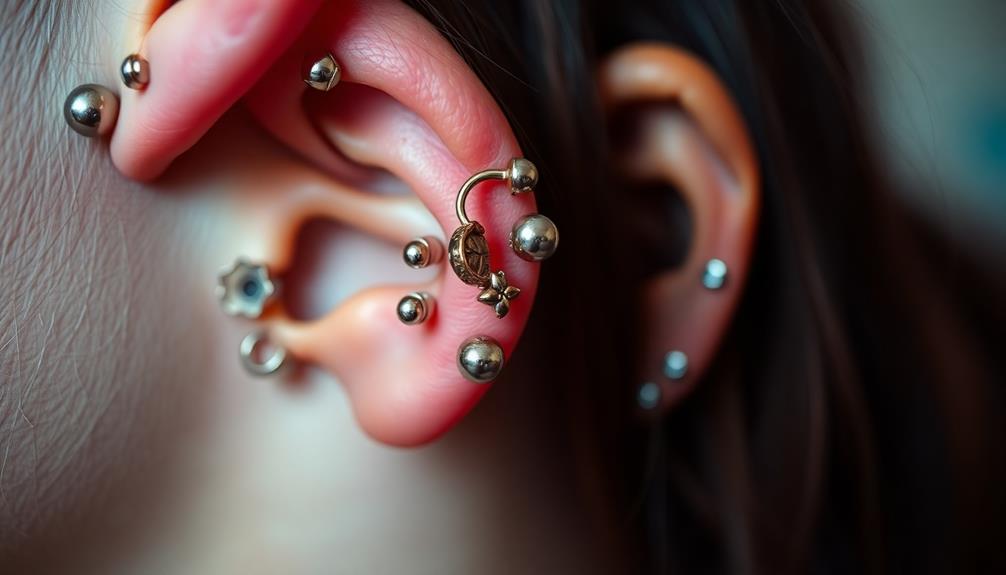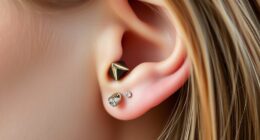Knowing your rights about piercings in the workplace is essential as acceptance of body art continues to rise. While companies can enforce dress codes that may restrict visible piercings, such policies must be communicated clearly and applied consistently. It's important to understand that body art isn't protected under federal discrimination laws, unless linked to religion or national origin. Review your company's employee handbook for specific guidelines and engage with HR if you have concerns. Maneuvering this space effectively involves knowing the rules and advocating for minor changes that foster inclusivity. You'll discover more about your options ahead.
Key Takeaways
- Body art, including piercings, is generally not protected under Title VII unless linked to religion or national origin, limiting legal recourse for discrimination.
- Employers can enforce dress codes that restrict visible piercings, especially in client-facing roles, to maintain a professional image.
- Dress codes must be clearly communicated and uniformly applied to avoid claims of discrimination among employees.
- Employees should review company policies in the employee handbook and document any inconsistencies in enforcement to advocate for change.
- Balancing personal expression with job security is crucial; consider alternative expressions that comply with company policies while engaging in discussions about inclusivity.
Industry Overview

The body art industry, encompassing both tattoos and piercings, is booming in the U.S., with around 21,000 tattoo parlors generating approximately $1.65 billion in revenue.
As an employee, you might be surprised to learn that about 14% of Americans have piercings beyond their earlobes, showcasing a growing acceptance of body art. This trend is particularly prominent among younger adults aged 26-40, with 40% of them sporting at least one tattoo.
Company culture plays a vital role in how organizations perceive body art during hiring processes. Many employers are adjusting their dress code policies to embrace diversity, recognizing that employees with tattoos and piercings can contribute unique perspectives.
With 32% of U.S. adults possessing at least one tattoo, it's clear that acceptance is rising across various demographics.
As you navigate your career, understanding your workplace's stance on body art is essential. Engaging with your company culture can provide insights into whether your tattoos or piercings align with their values, helping you make informed choices about self-expression in a professional setting.
Understanding Hiring Discrimination

When you think about hiring discrimination, it's essential to understand the legal landscape around body art like tattoos and piercings.
Currently, there are limited protections under Title VII, meaning that unless your body art ties to religion or national origin, you may not have a strong legal case.
With nearly 9,100 discrimination charges filed last year, it's clear that while body art acceptance is growing, many still face challenges in the workplace.
Legal Protections Overview
While many people express themselves through tattoos and piercings, these forms of body art aren't protected by Title VII or other discrimination laws, leaving you vulnerable during the hiring process.
Unfortunately, this means you could face discrimination based solely on your appearance. Employers have the right to enforce a dress code policy that may exclude visible tattoos and piercings, perceiving them as unsuitable for the workplace.
It's important to understand that employment discrimination laws protect specific classes, including age, race, color, national origin, gender, and disability.
However, body art doesn't fall under these protections. Nearly 9,100 discrimination charges were filed with the EEOC last year, but claims regarding tattoos and piercings only qualify if they relate to religious or national origin beliefs.
If you're denied a job due to your tattoos or piercings, the legal avenues available to you're limited.
Without adverse employment action, you may not have grounds for a legal claim regarding discrimination related to body modifications. Awareness of these limitations can help you navigate the hiring landscape more effectively.
Discrimination Charges Statistics
Highlighting the stark reality of workplace discrimination, nearly 9,100 charges were filed with the Equal Employment Opportunity Commission (EEOC) last year. These claims cover various categories, including age, race, and disability. However, employment law doesn't explicitly address discrimination based on tattoos or piercings under Title VII.
To further understand the landscape of discrimination in the hiring process, consider the following statistics:
| Category | Number of Charges | Percentage of Total Charges |
|---|---|---|
| Age Discrimination | 2,500 | 27% |
| Race Discrimination | 3,400 | 37% |
| Disability Discrimination | 2,200 | 24% |
While dress codes may restrict body art, they don't always account for religious beliefs or national origin. This lack of legal protections emphasizes the need for awareness. If you believe adverse employment action occurred because of your appearance, you might have a claim. Understanding these statistics can empower you to navigate the hiring process with confidence, knowing your rights regarding discrimination based on body art.
Body Art Exceptions
Maneuvering the complexities of hiring discrimination can be challenging, especially regarding body art like tattoos and piercings. Unfortunately, body piercings and tattoos aren't covered under Title VII of the Civil Rights Act. This means you can't claim discrimination based on your body art unless it relates to your religious beliefs or national origin.
Employers have the right to enforce dress codes that may require you to remove or cover your tattoos and piercings. However, these policies must be applied uniformly across all employees and shouldn't discriminate against any protected characteristics.
The growing acceptance of body art in society doesn't translate to legal protections in the workplace, so you're often at the mercy of employer discretion.
If you feel you've faced discrimination due to your body art, you need to prove that you suffered adverse employment action, like not getting hired or being terminated. This proof can complicate legal challenges, making it essential to understand your rights and the policies of your workplace.
Stay informed and prepared to navigate these nuances as you seek to express yourself through body art.
Protected Classes Explained

Protected classes are groups defined by specific characteristics, like age, race, and gender, that deserve legal protection against discrimination in the workplace.
While there are laws safeguarding these groups, tattoos and piercings don't have the same level of protection unless they intersect with a protected characteristic.
Understanding these distinctions can help you navigate workplace policies more effectively.
Definition of Protected Classes
Understanding protected classes is essential for recognizing your rights in the workplace. Protected classes include characteristics such as age, race, color, national origin, gender, and disability—groups that warrant legal protection from discrimination. These legal protections were established to address historical injustices and guarantee fair treatment in employment and other areas.
Additionally, the LGBT community is included under protected classes through laws that address sexual orientation and gender identity.
It's important to note that while the trend of body art, including tattoos or piercings, is growing, these characteristics aren't protected under Title VII. This means that if your employer has policies regarding tattoos or piercings, they can enforce them as long as they don't discriminate against those in protected classes.
However, inconsistent application of these policies can lead to legal challenges, particularly if they disproportionately affect a protected class.
Knowing the definition of protected classes can help you understand whether you have grounds to challenge any discriminatory practices related to your appearance in the workplace. Stay informed about your rights to guarantee a fair working environment.
Tattoo and Piercing Protections
While body art like tattoos and piercings is increasingly accepted in society, the workplace often maintains stricter standards. Unfortunately, tattoos and piercings don't have specific legal protections under Title VII and discrimination laws, meaning your body art mightn't shield you from employer policies.
Title VII protects classes based on age, race, national origin, gender, and disability, but body modifications aren't included. Employers can enforce dress codes that limit visible tattoos and piercings, as long as they're applied consistently to all employees. This consistency is vital to avoid claims of discrimination.
Additionally, a significant percentage of employers perform background checks, which may inadvertently influence hiring decisions for candidates with visible body art background checks can influence hiring decisions. However, if your tattoos are religious in nature, you may have some recourse under Title VII, as employers must accommodate religious beliefs unless it poses an undue hardship.
It's important to understand your rights and the potential for discrimination in hiring practices, especially if you have visible tattoos or piercings. Knowledge of these regulations can empower you to advocate for yourself while traversing the workplace culture around body art.
Employers' Rights and Dress Codes

When it comes to dress codes, employers have the right to set standards that reflect their corporate culture and operational needs, including regulations on piercings. Your employer can require you to cover or remove piercings, especially in client-facing roles, to maintain a professional appearance and adhere to safety standards.
However, it's essential that these dress codes are clearly communicated and consistently enforced to avoid claims of discrimination. Employers must justify any restrictions on piercings as necessary for legitimate business operations.
Here's a quick overview of employers' rights regarding dress codes:
| Aspect | Details |
|---|---|
| Establish Dress Code | Employers can set appearance standards. |
| Communicate Clearly | Dress codes must be clearly outlined. |
| Consistent Enforcement | Policies should be enforced uniformly. |
| Change Policies | Employers can modify guidelines anytime. |
Legal Precedents in Dress Codes

Employers have the authority to enforce dress codes, but legal precedents provide insights into how these policies can be implemented without crossing into discriminatory practices. For instance, the Robert v. Ward case in 2006 established that employers can apply dress codes uniformly, as long as they don't target historically discriminated groups.
Similarly, the Cloutier v. Costco case upheld a dress code that prohibited facial piercings, reinforcing that employers can prioritize a professional image. Understanding how to maneuver these policies is fundamental for maintaining both personal expression and workplace professionalism, especially in environments where financial considerations for elderly care may impact dress code enforcement.
Additionally, the EEOC v. Kelly Services case confirmed that dress codes addressing safety concerns are legitimate. This means if your employer enforces a dress code to protect employees or customers, it's likely to be considered valid.
However, it's vital for employers to consistently apply these appearance policies to avoid potential discrimination claims. Legal precedents indicate that while dress codes can limit personal expression, they must be backed by legitimate business needs to withstand legal scrutiny.
Grooming Standards and Hygiene

Maintaining grooming standards and hygiene is vital for a professional work environment. Employers expect you to uphold cleanliness as part of these standards. If you struggle with hygiene issues, it's important to address them proactively, as employers aren't obligated to tolerate poor hygiene.
Offensive odors, for instance, should be handled discreetly. If you don't have a medical condition to justify those issues, your employer may take corrective action.
It's important to remember that the Americans with Disabilities Act (ADA) provides guidelines for how employers should handle hygiene situations sensitively, especially if medical conditions are involved. Employers can set specific grooming standards, which include expectations for a clean appearance to maintain professionalism.
If you face unique hygiene challenges, know that employers may need to provide reasonable accommodations to support you while complying with applicable regulations. This guarantees that everyone can meet the grooming standards necessary for the workplace.
Ultimately, prioritizing your grooming and hygiene not only reflects your professionalism but also respects the work environment and your colleagues.
Body Modifications and Policies

Body modification policies often play a significant role in shaping workplace culture and expectations. As you navigate your career, it's vital to understand how these policies can affect you.
Employers must clearly communicate their dress code regarding body modifications, including tattoos and piercings, to guarantee everyone is on the same page. In client-facing roles, it's common for employers to require you to conceal tattoos or remove piercings to maintain a professional image.
While the prevalence of body modifications is rising—14% of Americans have piercings beyond earlobes, and 32% have at least one tattoo—employers still have the right to enforce policies as long as they don't interfere with job performance.
However, you should be aware that inconsistent enforcement of these policies can lead to discriminatory practices and potential legal challenges. If you feel that body modification policies are applied unevenly, it's important to address your concerns with HR or management.
Understanding the balance between personal expression and workplace expectations can help you navigate these policies while remaining true to yourself.
Changing Attitudes Toward Body Art

As workplace policies evolve, attitudes toward body art are shifting clearly. In 2023, a significant 32% of U.S. adults sport at least one tattoo, marking a robust cultural acceptance of this form of self-expression.
With 80% of adults acknowledging increased societal acceptance over time, it's clear that changing attitudes toward tattoos are influencing perceptions in various environments, including workplaces.
You might find it interesting that certain demographics embrace body art more than others:
- 51% of LGBTQ+ adults report having at least one tattoo.
- The prevalence is considerably higher among women and Black and Hispanic adults.
- Younger individuals, particularly those under 50, are more likely to have tattoos.
- A surprising 66% of untattooed adults claim tattoos don't sway their opinions on others.
Despite these trends, some still worry about discrimination based on body art.
However, as acceptance grows, it's essential for you to stay informed about your rights and your company's policies. Understanding these changing attitudes can empower you to navigate your workplace confidently, fostering a culture that embraces diversity and individuality.
Legal Protections for Employees

Steering through workplace policies on piercings can be tricky, especially since employees have limited rights to express their personal style through body art.
Generally, your ability to wear piercings at work hinges on the company's dress code. Employers can set restrictions on piercings, including clear retainers, unless they pose safety risks. This means you don't have an inherent right to wear piercings unless they relate to sincerely held religious beliefs, which are protected under Title VII.
Title VII offers legal protections for employees, allowing you to express religious beliefs through body art. However, if your piercings don't fall under this umbrella, you risk facing disciplinary actions or even termination for non-compliance with dress code policies.
If you suspect that your employer's piercing policies are discriminatory, it's essential to take action. Start by consulting your HR department to discuss your concerns.
If the enforcement of dress codes seems inconsistent, seeking legal advice may also be necessary. Knowing your rights can empower you to navigate these policies more effectively while ensuring that your personal expression doesn't come at the cost of your job security.
Frequently Asked Questions
What Is the Company Policy on Piercings?
You should check your employee handbook for the company's policy on piercings. It's essential to understand how your workplace views body art and what guidelines you need to follow for maintaining a professional appearance.
Can You Ask an Employee to Remove Piercings?
Yes, you can ask an employee to remove piercings if it aligns with the company's dress code. Just guarantee the policy is communicated clearly and doesn't discriminate against any protected classes.
Can Companies Establish Policies to Prohibit Employees From Having Visible Tattoos and or Visible Body Piercings?
Yes, companies can establish policies prohibiting visible tattoos and piercings. They often align these rules with corporate culture and professional image standards, ensuring consistent enforcement to avoid discrimination claims against protected groups.
What Piercings Are Acceptable in the Workplace?
Imagine stepping into a polished office, where professionalism shines. Acceptable piercings often include small studs or discreet pieces. Always check your company's guidelines; they'll clarify what's appropriate and keep you aligned with workplace expectations.
Conclusion
In the ever-evolving workplace, understanding your rights about piercings and body art is essential. Just like a canvas reflects the artist's vision, your appearance can express who you are. Stay informed about your company's policies and remember that attitudes toward body modifications are shifting. By knowing your rights, you can navigate the corporate world with confidence, ensuring your individuality isn't stifled. Embrace your unique style while advocating for a workplace that values diversity and inclusion.
Hi, my name is Danielle, and I’m an author for piercings-body.com. I have a passion for writing and love to share my knowledge on all things body piercing-related. I’m also a huge advocate for safe body modification practices and believe everyone should be able to make informed decisions about their bodies. When I’m not writing or blogging, I enjoy spending time with my family and friends, practicing yoga, and exploring new places.

















